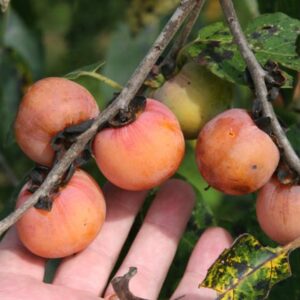Alachua Muscadine
$24.95 – $39.95
2025 Shipping Season
We are accepting orders to ship through Summer or for Fall delivery.
For more information see the Ordering & Shipping section below.
Alachua Muscadine Grapes make for a wonderful addition to your garden or property. The vines are perfect for a trellis or fence, creating a luscious backdrop for your landscape. The fruit themselves are dark purple in color with an aromatic flesh that is perfect for making wine, jams, or eating straight off the vine.
Muscadine Grapes are an excellent source of sweet, delicious nutrition, enjoyed by wildlife and humans alike. Muscadines produce, large, sweet, juice-filled grapes with thick skins. Muscadines are native to North America.
Muscadines do well on a wide range of soils, but rich sandy loam or clay loam soils are preferred. Grapes do not tolerate flooding and may grow poorly in mucky soils unless planted in raised mounds. Plants will grow more vigorously and produce more fruit in full sun. Grapes prefer slightly acid soil (pH 6.0-6.5), but soils of up to moderate alkalinity are tolerated. Pollinator is required so plant more than two.
| Height | 8' - 12' |
| Spread | 6' - 8' |
| Tree Form | Vine |
| USDA Zone | 7 - 10 |
| Blooms | Spring |
| Drops Fruit or Nut | August |
| Soil | Sandy or clay loam, slightly acidic |
| Soil pH | 6.0 - 6.5 |
| Light requirements | Full Sun |
| Pollination | Self-fertile |
| Age shipped & Size shipped: | 1 year old & 18-36 inches |
| Spacing | 2' - 5' |
| Pruning | Train to trellis. Fruit is produced on new shoots developing from the previous year’s growth. In Year 3, canes produced the previous year should be pruned to approximately 3 in. long in January or February. These canes will produce several shoots that will fruit during the following summer. These new shoots will be cut back to 3 in. the next winter, forming the first fruiting spurs. Depending upon the growth rate of the plants, spurs will need to be thinned in Year 5 or 6 after planting. During the winter pruning, remove every other shoot, aiming for a fruiting spur every 6 in. on each arm. Choose spurs on the top of the vine, if possible. Allow a few extra shoots to grow from the arms to form replacement spurs as the vine ages. Remove tendrils twining around the arms or spurs to prevent girdling |
| Fertilization | Do not fertilize at planting. Once the trees are established, fertilize in early spring (Mar-April) as growth begins. Do not fertilize in the fall, which could promote late season tender growth that can be damaged by early frosts. |
| Watering | Newly planted trees should be watered regularly. This is the most critical step in the establishment of your new trees. Please see the Watering section under "How to plant and grow" in our Learning Center. |
At Chestnut Hill Outdoors, we’ve been shipping mail order trees for over 30 years. We’re experts at delivering healthy trees to your doorstep. All of our trees are container grown in root-enhancing pots, ensuring healthy root systems and much better success upon planting.
In Spring we ship bare-root, dormant trees. All plants are dipped in a root gel before shipping and wrapped in plastic to retain moisture.
Spring: All trees are shipped bare-root.
Fall: All trees are shipped in containers.
Size shipped: 18-36 inches
Age Shipped: 1 Year Old
For more information, visit our Ordering & Shipping Page.









